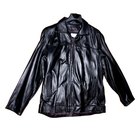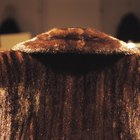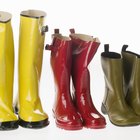
Sheepskin coats have many significant attributes, many of which are a result of the remarkable wool-leather combination: it retains its shape, it resists snags, tears, wrinkles, soiling, pilling and shedding, its flame and water resistant and stays warm even when wet. Most of all, it's an extremely breathable fabric, keeping you cool in the summer and warm in the winter. However, it's not completely flawless and can wear out due to excessive use. Luckily, you can fix most rips or holes yourself.
Rips and Tears
Thread your needle and knot it at the end. Pinch the ends of the ripped sheepskin between your fingers and sew 1/2 inch before the rip starts, sewing over and reinforcing the stitches that are already there. It's best to sew on the inner side of the coat, against the sheepskin, penetrating into the leather.
Sew small, tight stitches over the rip matching the size of the stitches already on the coat. According to Claire Shaeffer, author of the book, \"Claire Shaeffer's Fabric Sewing Guide?,\" you should stitch slowly and hold the leather taut to monitor an even stitch length. If desired, sew two rows of stitches, directly on top of each other to reinforce the area.
Sew 1/2 inch past the rip on the stitches that are already there and knot your thread on the inner side of the coat. Knot it several times to ensure tightness and cut away extra thread.
Add a dab of glue, such as leather glue or rubber cement to the inside of the seam. According to Shaeffer this helps your seam remain flat, and also fills in any needle holes you might have created in the sheepskin with your needle.
Larger Holes
Purchase a patch of sheepskin that matches the color of the leather and wool of your coat. You can buy such patches at fabric stores or at car upholstery repair shops.
Cut a patch that is just faintly larger than the hole in your coat. You just need a slight perimeter that will rest around the hole by 1/16 of an inch.
Trim the wool side of your patch around the edges so that you create a faint circumference of leather around the patch.
Test the glue first on scraps of sheepskin. Shaeffer asserts that you should always test the glue first\"
Apply leather glue or rubber cement to this perimeter. Shaeffer recommends that you wait for the glue to become tacky before pressing the patch onto the hole, covering it. Allow it to dry according to the manufacturer's instructions, giving it at least 24 hours.
Related Articles

How to Remove Patches From Leather ...

How to Repair Cigarette Burns in Leather

How to Repair a Torn Lambskin Leather ...

How to Repair Stitching Holes in ...

How to Comb the Furry Hood of a Jacket

How to Fix a Ripped Winter Coat

How to Alter the Length of a Leather ...

How to Turn a Fur Coat Into a Fur Jacket

How to Fix a Mink Coat Whose Pelts Are ...

How to Waterproof a Leather Jacket

How to Condition a Dried Leather Biker ...

How to Fix Holes in Stockings

How to Make a Wool Jacket Look New Again

How to Clean a Peacoat

How to Alter the Sleeves on Fur Coats

How to Repair Heat Damaged Leather

How to Sew a Patch on Jeans

How to Repair a Leather Jacket Lining

How to Patch Small Holes in Polar Fleece

How to Fix Ripped Rubber Boots
References
- "Claire Shaeffer's Fabric Sewing Guide"; Claire Shaeffer; 2008
Writer Bio
Lane Cummings is originally from New York City. She attended the High School of Performing Arts in dance before receiving her Bachelor of Arts in literature and her Master of Arts in Russian literature at the University of Chicago. She has lived in St. Petersburg, Russia, where she lectured and studied Russian. She began writing professionally in 2004 for the "St. Petersburg Times."
Photo Credits
sheepskin gloves image by Alison Bowden from Fotolia.com